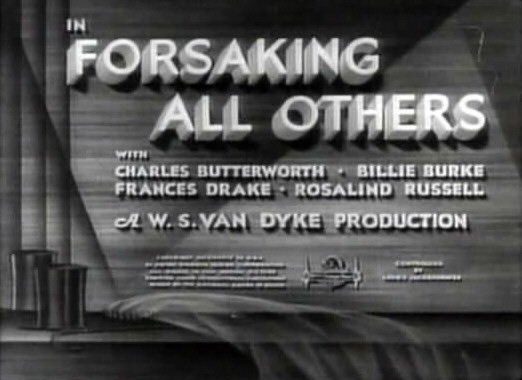
The Best of Everything
Encyclopedia Entry • Films Main
Forsaking All Others
1934

Critics' Reviews • Our Reviews • Movie Posters • Lobby Cards • Misc. Images
Click here to see photos from the film.
US release: 12/23/34. VHS release: 6/24/92. Warner Archive DVD release: 3/23/09. Cast: Joan Crawford (as "Mary"), Clark Gable, Robert Montgomery, Charles Butterworth, Billie Burke, Frances Drake, Rosalind Russell, Tom Rickets, Arthur Treacher, Greta Moyer. Credits: From the play by Edward Barry Roberts and Frank Morgan Cavett. (Trivia: Tallulah Bankhead starred in the 1933 staging.) Screenplay: Joseph Mankiewicz. Producer: Bernard H. Hyman. Director: W.S. Van Dyke. Camera: Gregg Toland and George Folsey. Costumes: Adrian. Editor: Tom Held. Plot Summary: For 20 years, Jeff Williams (Clark Gable) has been in love with his childhood playmate Mary Clay (Joan Crawford). Alas, Jeff has never said as much, thus Mary becomes engaged to another childhood friend, Dill Todd (Robert Montgomery). Returning from a trip to Spain for the purpose of proposing to Mary, Jeff is taken aback when he learns of the impending marriage. Stout fellow that he is, however, he agrees to act as Dill's best man. Comes the day of the wedding, and Dill leaves Mary at the altar to run off with his mistress Connie (Frances Drake). Jeff stays behind to console Mary -- yet he still doesn't tell her how much he loves her. Small wonder, then, that a chastened Dill is able to rekindle his romance with Mary and plan a second ceremony. Disillusioned, Jeff is about to return to Spain, when at the last minute, comedy-relief Charles Butterworth tells Mary what's up with Jeff. "Suddenly everything is clear!" says Mary -- 84 minutes after the MGM lion introduced Forsaking All Others. Its plot absurdities aside, this star vehicle is splendidly glossy entertainment. ~ Hal Erickson, All Movie Guide |
Louella Parsons in the Los Angeles Examiner January 25, 1935 Forsaking All Others may not be Joan Crawford's greatest achievement, but at least it is her best performance since she became screen conscious. In many ways it's the Joan who used to delight us with her naturalness, her young beauty and her merry quips. I liked the comedy, and from the laughter that greeted some of the dialogue the patrons of Loew's State apparently agreed with me. Forsaking All Others is also playing at Grauman's Chinese. Light, frothy, amusing, it's the
story of a girl who is jilted at the very altar. The lad who turns away
into another woman's waiting arms is Robert Montgomery. No one can be
as witty or more delightful than the naughty Bob. He succeeds in making
us understand why he walked out on Joan, who looks very lovely--and I
call that an achievement. I don't know why MGM put Clark Gable into
this picture. He gives, it's true, a beautiful performance, and, as I
said, the picture is entertaining; but the part is hardly big enough
for Clark, who today is at the very top. He's the best friend of Joan,
and after much watchful waiting he finally succeeds in winning her away
from Bob--I mean after she has forgotten Bob's desertion and he has
divorced the vamp who carried him away. Frances Drake, as that
siren, reveals unexpectedly ability. She is a worthy screen companion
for those three accomplished players, Joan,
Bob and Clark. In fact, in several instances she is a bold scene
stealer. Billie Burke, as the fluttery mother of Joan, again looks
absurdly young, and, as usual, is splendid in her light comedy moments.
As for Charles Butterworth, as Gable's close friend--well, he is
himself. What more can I say?" While this society drama is hardly
up to W.S. Van Dyke's alley, he does a really great piece of directing.
Without him, it probably would have been deadly. He manages to get in
all the little touches that mean so much to a picture of this kind. Forsaking All Others is a Bernie Hyman production, and, as I said,
while it's not a great picture, it's the kind that is entertaining and
amusing enough to offset its shortcomings. In addition to the feature, there is a Fitzpatrick Traveltalk, Zeeland, the Hidden Paradise; Casting For Luck, the adventures of a cameraman, a Mickey Mouse cartoon and the Hearst Metrotone Newsreel.
Variety (1935): On the performance end, it is one of Miss Crawford's best. She is believable throughout. That tongue-in-cheek moralizing which often marks many of her sagas is largely missing. This is just a semi-rowdy, semi-drawing room eternal triangle. |
If you've seen Forsaking All Others and would like to share your review here, please e-mail me. Include a picture of yourself or avatar to accompany your review, as well as a star-rating (with 5 stars the best) and any of your favorite lines from the film.
|
Rating:
Gawd, how tedious this thing is. I nearly added a half-star for constant alleged witticisms and/or just for the fact that Joan/Clark appeared in it---and they're never bad---but... Nah.
The script by Joseph Mankiewicz is cold and dully/duly "witty." Yes, we get brittle "witticisms" a-plenty, but they're constantly, randomly tossed about just for show and have nothing to do with either the characters or the plot. (No kudos, also, to director W.S. Van Dyke---who had just directed the previous year's excellent "Thin Man" and should have known better. Co-star Robert Montgomery is also particularly un-funny and un-charming.)
This film's thin plot: Mary (Joan), Dill (Robert Montgomery), and Jeff (Clark Gable) are childhood friends, and Jeff has just returned from Spain to discover that his love Mary is about to be married to Dill the next day. The caddish Dill then runs off with his former Paris paramour Connie (Frances Drake) the night before the wedding.
Cut to abandoned-bride Joan trying to recover in the Adirondacks, chopping wood (!) and boating and swimming, and then being visited by Gable, who delivers an invite to Dill and Connie's party celebrating THEIR wedding. (The subsequent party "showdown" between Mary and Connie isn't THAT exciting at all, as it should have been.)
A few minutes later into the film, Dill knows he's made a mistake and invites Mary for a drive. After numerous highly UN-funny slapstick bits, Dill and Mary wind up at a house owned by Mary's aunt, where yet more UN-funny slapstick bits occur. As I said: It's tedious. Not only the weak slapstick bits like getting in a car wreck and ordering from a hamburger stand and falling into pig pens, but also the subsequent supposed "morality tale" once Mary and Dill arrive at the abandoned house: The few minutes of Dill and Mary in the house are boring, as is the next-day discovery by others that they'd spent the night together. (This is supposed to be a scandal? Even in 1934, I doubt it.)
Overall: Montgomery is constantly un-funny. He tries mightily in the many trying-to-be-funny scenes: Shower, driving, house---Yet he's always stilted and awkward.
A few interesting things for Joan fans to watch: The opening scene with Joan in cold-cream and getting a brutal massage from Bella was certainly unusual to look at! And the photo of Mary/Dill/Jeff with kid bodies but adult faces was certainly odd!
According to the AFI site, this film was initially supposed to feature Loretta Young, George Brent, and Joel McCrea. That seems about right. Joan Crawford and Clark Gable were utterly wasted here.
Rating:
Forsaking All Others (1934) is a romantic comedy with an admixture of slapstick, farce, and screwball comedy. Maybe that’s why, after three viewings, I'm still not sure what to make of this film. The first time I saw it was during Joan’s reign as TCM Star of the Month. The next time, I watched with a mindset that it was a romantic drama; but then the comedic prelude seemed a roadblock to the “good stuff"--- Joan and Clark hooking up. Before my most recent viewing, I read some reviews and decided I would view the film as a comedy. Alas, the melodramatic last half then seemed to drag on like a post-Code Kay Francis “weepie." Maybe it’s my uncertainty of what the film is trying to do that makes it one of my less-favorite Crawford-Gable pairings.
The performances by the lead three actors (Joan, Gable, Robert Montgomery) are OK, just not up to their exalted standards, in my opinion. Joan is in the midst of her reign as Queen of the Love Triangle, and her clueless character Mary, who cannot see that Dill (Montgomery) is a clod and that Jeff (Gable) is her true love until the closing minutes beggars belief. (For one second could Mary really think a self-absorbed nitwit like Dill would have remembered cornflowers were her favorites?) Gable was coming off an Oscar-winning performance in It Happened One Night, and this was his 5th pairing with Joan. Montgomery and Joan had worked together since Joan’s first talkie, Untamed (1929). One thus might have expected a well-oiled machine. I think the script did not give any of them much to work with. Maybe MGM’s plan was to capitalize on star power plus the opulence of rich dilettanti to drive Great Depression audiences to see this film? This movie did the second-most business of any movie in 1934, after the Cecil B. DeMille-directed spectacle Cleopatra, even ahead of Oscar-sweeping It Happened One Night. So, perhaps my dilemma with Forsaking arises from viewing it through a lens that is 90+ years old. The box-office receipts would suggest MGM knew what it was doing.
Notable among the credited supporting cast are Charles Butterworth as Shemp, drinking buddy to Jeff/Clark; Billie Burke as Joan’s flibbertigibbet aunt; and Roz Russell in one of her earliest flicks, showing comedic chops that would make her a star. Even the bit players are a seasoned cast. Picking just a few: Sydney Bracey (349 credits per IMDB); Edward Hearn (403 credits; he played George Washington in the Joan silent Winners of the Wilderness [1927], by which time he had been in show business for more than a decade); Pat Flaherty (207 acting credits), and so forth. Mary's ancient butler, played by Tom Ricketts, is credited with directing the first film shot in Hollywood and had 300+ film credits!
Special
kudos to Frances Drake, who I think walks away with this movie as the
man-stealing, Joan-hating Connie. She’s nasty and will stop at nothing
to get the man she wants, even if it means seducing him the night before
his wedding. Connie also invites
Mary to a party at her house after she has stolen Dill from her,
presumably to gloat. As discussed in this
excellent review: http://pre-code.com/forsaking-others-1934-review-joan-crawford-robert-montgomery-clark-gable/.
My dissatisfaction with Forsaking All Others lies in the thought that this could have been so much better, perhaps given a better script and with the given cast and an accomplished director like Van Dyke---maybe even a true classic in the Joan filmography. It could have pushed her career in a different direction, one akin to that of Carole Lombard, or if not one of the foremost screen comediennes, perhaps it may have provided MGM with incentive to let Joan diversify her acting portfolio before she was labeled “Box Office Poison” in 1938, when the public seemingly tired of her Adrian-gowned melodramas and their requisite love triangles. In fairness, I reiterate that this was the 2nd-highest-grossing Hollywood film of 1934, and making money in the midst of the Great Depression was nothing to be dismissed.
Rating:
One of my very favorites and for a lot of reasons: Clark Gable with that gleam in his eye. Robert Montgomery with his Charming charm. Rosalind Russell in the lucky role of “best friend” to the star: spunky and full of little nuances; fun to watch her pal around with Charles Butterworth (a fine man and a fine comedian). Frances Drake performing like a 40s femme fatale in a 30s script, wonderful in that gown that makes noise when she moves.
And the best for last -- BILLIE BURKE!! Can you ever go wrong with her? I don’t care how she treated Marilyn Miller. She is a breath of flawless comedy and a character. Makes me happy and makes me sing watching her speak with that indelible voice and fluttery acting style.
Now for Miss Crawford: I like her, even with all that socialite lip gloss and Adrian standing on her shoulders. She is snappy and happy, of course because Billie Burke is her aunt and she has two men after her.
I am sorry for Miss Tallulah Bankhead that her Broadway run did not succeed; but this film version does succeed and it is a glittering show. Miss Crawford sparkles like any screwball comedy queen. And I can tell you none of those girls can part their hair like Miss Crawford.
Enjoy MGM at its best, showing off easily with some of its best. I can watch this movie and always be carefree and happy. (One last thing: Will somebody write a book about W.S. Van Dyke? The man is an artist.)
Mike O'Hanlon (December 2008) Rating:
[Warning: Review contains spoilers!] We’re first introduced to Joan's Mary Clay getting ready for her wedding the next day while getting beaten up on the massage table by Bella, who says that Mary is a “sucker to get married.” “Is this horrible mess the woman who’s about to be my bride?” Dill (Robert Montgomery) asks as he enters the room, making a cocktail. When childhood friend Jeff (Clark Gable) calls Mary to tell her he’s in town, Mary has some big news: She's about to marry their mutual childhood friend, Dill. (A funny moment comes when Jeff shows up at the house and focuses on a weird picture of the three together as kids: “It was the same thing then,” Jeff says. “I pumped all the tires on that bicycle but Dill did all the riding.” The photo is a real crack-up. Seriously. It’s clearly a picture of three pre-teens with the faces of Gable, Montgomery, and Crawford pasted on. It’s Photoshop circa 1934.)
Mary's husband-to-be Dill’s a funny guy, but he can’t stay true to just one woman. Connie is his side-piece (Frances Drake is a pleasure to watch as the cheap tramp). On the day of the wedding, Mary is in awe of the beautiful cornflowers surrounding her as she prepares. She thinks they're from Dill, but they're really from Jeff, who remembers that she loved them as a girl. Because of his inability to commit himself to one woman, Dill is nowhere to be found when the wedding begins. Jeff gets a telegram from Dill saying that he has, instead, married Connie... This is one of those loveable, but frustrating, comedies of the mid-1930s. With It Happened One Night and The Thin Man drawing in long lines at the box office, studios decided that the melodramatic women’s stories were a thing of the past. With censorship in full bloom after July 1, 1934, stories about prostitutes and scandalous ladies could no longer be produced. It was a smart business move from the studios, but it hampered the careers of many great female stars. Joan Crawford’s was among them. Of the performances, however, Crawford’s reigns supreme of the top-billed three. She tries a little too hard in the opening scene where she’s being massaged, and that false speech of hers can be a little annoying, but she’s far more realistic than the clumsily over-the-top Clark Gable. Even the way he spits his lines out comes off as phony, and the same problem goes for Robert Montgomery, who almost acts like he’s trying to portray a college frat boy. I’ll give them some leeway, though, since their parts aren’t much. Forsaking All Othersrepresents the drastic change in movies that were currently being filmed as the Code went into full effect. There was a struggle back and forth between MGM and director W.S. Van Dyke and Joseph Breen and his group of hypocritical Catholic censors. When the studio and Van Dyke ignored Breen’s suggestion of cuts, he retaliated by telling them they could either cut the suggested scenes or shelve the movie altogether. It wouldn’t be shown as is, particularly the relationship between the characters portrayed by Montgomery and Frances Drake. Van Dyke refused to film the retakes, and Richard Boleslavsky was the one who had to go in there behind the camera and clean up the movie. “We redid a lot of Crawford’s close-ups, too,” cinematographer George Folsey remembered. “We were always going in there and reshooting things that Van Dyke rushed right through.” Clearly the retakes of Joan Crawford’s close-ups
worked well. She’s beautifully photographed throughout the entire
movie. But her close-ups are done well in simple lighting, none of that
over-exaggerated lighting which was often used for Marlene Dietrich. No matter how dated the comedy may be today, Forsaking All Others was a huge success after its initial release. The unfortunate side of many of Joan Crawford movies of this era is that they run too long, with too many unimportant asides. Their box-office fluff stretched to about an hour and a half, when they could have easily been cut down to no longer than seventy-five minutes. Not that it’s her fault, though. She, Montgomery, and even Gable deserved material much better than this.
|
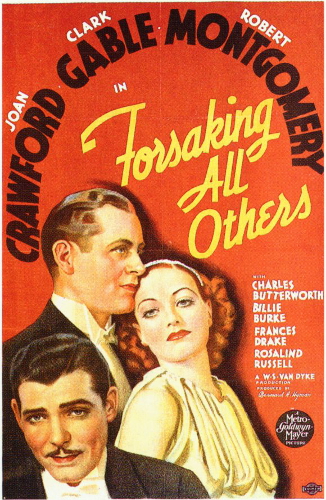




Above: US posters.
Below:
Belgium and Netherlands posters.

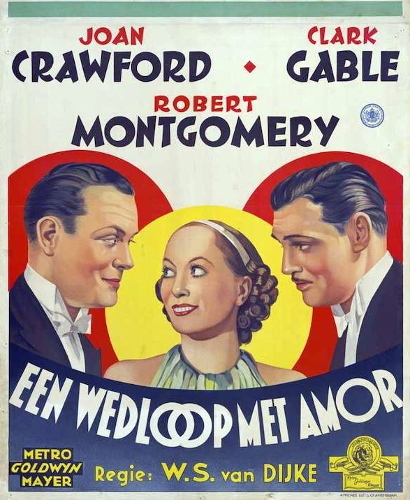


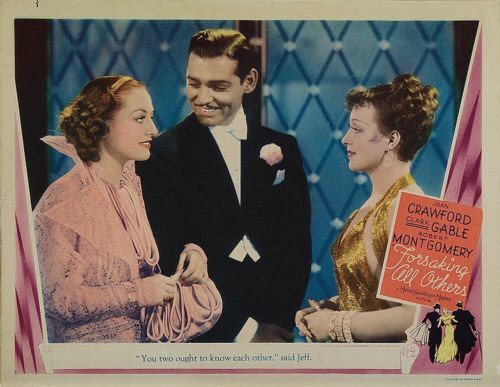

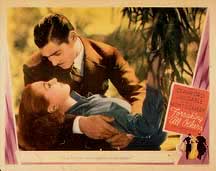
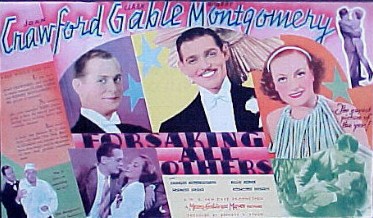

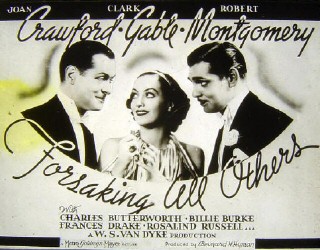
Above: US program, US newspaper ad, and US glass slide.
Below: London program cover (April 1, 1935), and three window cards.
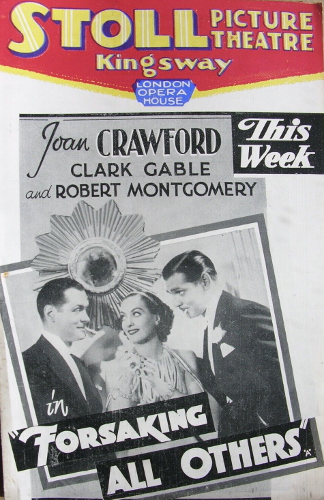

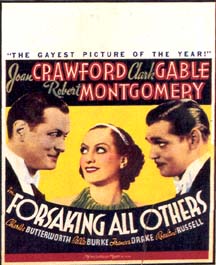

Below: A US program.

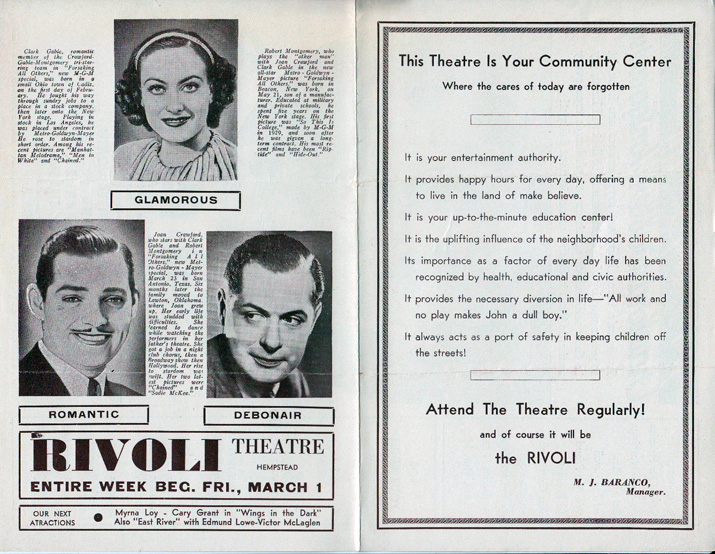
Below: Spanish novelization (72 pp., 8 pp. photos, 8.5 x 6.25 inches)
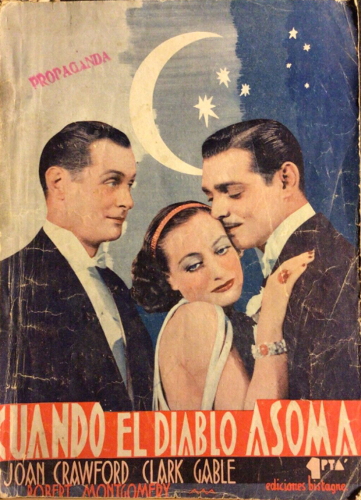
The Best of Everything